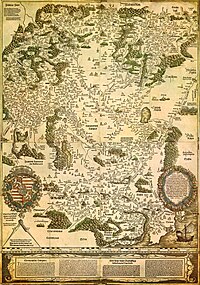
Photo from wikipedia
Abstract The Middle to Upper Palaeolithic transition is one of the crucial periods of change in the prehistory of Europe due to the full emergence, continent-wide, of modern human lithic… Click to show full abstract
Abstract The Middle to Upper Palaeolithic transition is one of the crucial periods of change in the prehistory of Europe due to the full emergence, continent-wide, of modern human lithic technologies, and detrimental of Neanderthal survival. Knowledge about the transition is growing, however, the evidence for cultural and technological developments for the Middle Palaeolithic in the Carpathian – Lower Danube Basin is still rather sparse. Here we discuss latest findings arising from a chronological investigation of Middle Palaeolithic assemblages within the Varghis karst, Eastern Transylvania, Romania. Combining our first chronological results with information from previous excavations, we can distinguish two main stages of habitation (albeit Middle Palaeolithic lithics and faunal remains appear scattered throughout the investigated profile) within the Abri 122 rock shelter. In order to augment the typological cultural considerations, we applied direct radiocarbon dating on bones and charcoal from within the occupation layers. Radiocarbon dating of bones suggests that the Middle Palaeolithic sequence is older than the upper dating limit of the method, whereas direct luminescence ages on the lowermost productive horizon and immediately above it indicate surprisingly old ages of ca. 106–141 ka (OSL – optically stimulated) or 99–174 ka (IRSL – infrared stimulated). Multiple-protocol dating of charcoal found within the two habitation layers produced ages >38 14 C ka BP, also suggesting that the lowermost lithic-rich horizon pertains to the Middle Palaeolithic industries. Overall, the recovered lithics, currently forming one of the most significant collections for Romania, are fully consistent with two main habitation phases connected to Middle Palaeolithic cultural affinities. The occurrence of a volcanic ash layer within Ursului Cave and originating from the Ciomadul volcanic complex (Carpathians) is first reported here. Recently dated to ∼ ≥ 43 (−50) ka, it might represent an important marker horizon, providing that it is identified within other Palaeolithic cave assemblages.
Journal Title: Quaternary International
Year Published: 2017
Link to full text (if available)
Share on Social Media: Sign Up to like & get
recommendations!